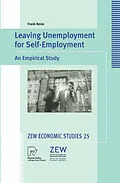The book presents an analysis of the transition from unemployment to self-employment and its subsidisation with the so-called "bridging allowance" in Germany. On the basis of econometric models, the determinants and the success of self-employment among former unemployed are estimated at the individual as well as at the firm level. By comparing different groups of the formerly unemployed, it becomes evident that self-employment is one successful route out of unemployment, as self-employment proves to be more stable than paid-employment. Therefore, the bridging allowance reaches its aim of regaining stable employment for the unemployed. However, this programme fails to create additional employment in the newly founded firms.
Inhalt
I: Facts, Institutional Arrangements and Evaluation Strategies.- 1 Overview and Introduction.- 2 Unemployment, Self-Employment and Bridging Allowance.- 2.1 Trends in Unemployment and Self-Employment in Germany.- 2.2 Causes of the Trends.- 2.2.1 Unemployment.- 2.2.2 Self-Employment.- 2.3 Bridging Allowance as an Active Labour Market Programme.- 2.3.1 Institutional Arrangements and Adjustments.- 2.3.2 Aim and Potential Impacts.- 3 Previous Empirical Findings on the Transition from Unemployment to Self-Employment.- 3.1 Analysis of Bridging Allowance.- 3.2 Further Empirical Findings.- 4 Evaluation Strategies.- 4.1 The Sample Selection Bias.- 4.2 Addressing the Sample Selection Bias.- 4.2.1 The Control Function Estimator.- 4.2.2 The Heckman Selection Model.- 4.3 Evaluation of Bridging Allowance at the Individual Level and at the Firm Level.- II: From Unemployment to Self-Employment.- 5 Theoretical Framework - An Extended Search Model.- 6 Determinants and Success of Self-Employment.- 6.1 The Empirical Model.- 6.2 The Discrete Hazard Rate Model with Unobserved Heterogeneity.- 6.2.1 The Hazard Rate in Discrete Time.- 6.2.2 Specifying Unobserved Heterogeneity.- 6.2.3 Testing the Independence of Irrelevant Alternatives (IIA) Assumption.- 6.3 Measuring the Success of Self-Employment.- 6.3.1 The Stability of Self-Employment.- 6.3.2 Income Effects of Self-Employment.- 6.4 Data, Sample and Variables.- 6.4.1 The German Socio-Economic Panel.- 6.4.2 Samples of Analysis.- 6.4.3 Variables, Definitions and Descriptives.- 6.5 Econometric Results.- 6.5.1 Choice of the Number of Mass Points.- 6.5.2 Determinants of Self-Employment.- 6.5.3 Stability of Self-Employment and the Effects of Bridging Allowance.- 6.5.4 The Development and Distribution of Income.- 6.6 Summary and Conclusions.- III: Firm Start-Ups by the Unemployed.- 7 Microeconomic Issues on Firm Start-Ups.- 8 Assessing the Impact of Bridging Allowance at the Firm Level.- 8.1 Econometric Modelling.- 8.1.1 Firm Start-Ups and Selectivity.- 8.1.2 Modelling Firm Survival.- 8.1.3 Modelling Employment Growth.- 8.2 Data, Variables and Descriptives.- 8.2.1 Data.- 8.2.2 Firm Heterogeneity and Subsidisation of the Unemployed.- 8.2.3 Factors Influencing Company Success and Firm Selection.- 8.2.4 Survival Probability and Employment Growth.- 8.3 Econometric Results.- 8.3.1 Start-Ups by the Unemployed.- 8.3.2 Firm Survival.- 8.3.3 Employment Growth.- 8.4 Summary and Conclusions.- IV: Concluding Remarks.- 9 Political Options and Future Research.- A.1 Calculation of the IRR and SPIR.- A.2 Tables of Chapter 6.- A.3 Figures of Chapter 6.- A.4 Tables of Chapter 8.- List of Figures.- List of Tables.
